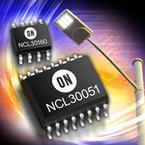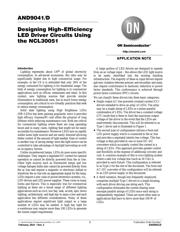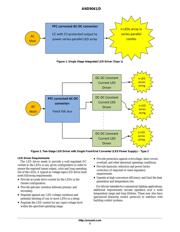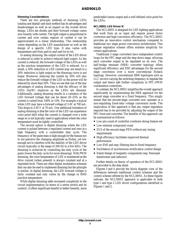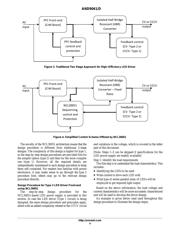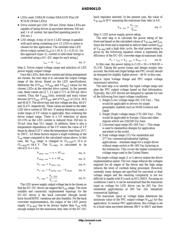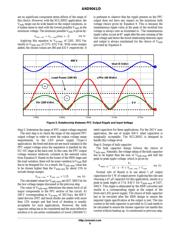herunterladen

© Semiconductor Components Industries, LLC, 2014
February, 2014 − Rev. 2
1 Publication Order Number:
AND9041/D
AND9041/D
Designing High-Efficiency
LED Driver Circuits Using
the NCL30051
Introduction
Lighting represents about 1/6
th
of global electricity
consumption. In advanced economies, this ratio may be
significantly higher due to high commercial usage. For
example, in the US it is estimated that only 28% of the
energy consumed for lighting is for residential usage. The
bulk of energy consumption for lighting is in commercial
applications such as offices, restaurants and retail. In this
context, new lighting sources that provide similar
illumination to traditional ones, but at much lower energy
consumption, are critical to eco-friendly practices that seek
to reduce energy consumption.
Solid state lighting using High Brightness LEDs
(HB−LEDs) has been gaining popularity since it provides
high efficacy (lumens/W) and offers the promise of long
lifetime while reducing maintenance cost. Both are critical
for commercial lighting where there are long operating
hours and in many cases, lighting that might not be easily
accessible for maintenance. Moreover LEDs turn on rapidly
unlike some light sources and are easily dimmed allowing
better control of the amount of light needed. Ease of control
is another way of saving energy since the light source can be
controlled to take advantage of daylight harvesting as well
as occupancy factors.
Unlike incandescent lamps, LEDs do pose some specific
challenges. They require a regulated DC current for optimal
operation so cannot be directly powered from the ac line.
Other light sources such as fluorescent lamps and low
voltage halogen bulbs also cannot be powered directly from
the ac line and require a magnetic or electronic ballast to
transform the ac line into an appropriate signal for the lamp.
LEDs require a new class of power electronics systems, viz.,
LED drivers and LED power supplies. These come in many
forms and flavors. This is especially true for commercial
lighting as there are a broad range of different lighting
applications such as cove, low bay, task, accent, spot, down
lighting, architectural, and high bay to name a few and each
application has different considerations. Many of these
applications require significant light output so a large
number of LEDs may be needed. A high bay light for
a warehouse may require more than 100 LEDs to generate
the lumen output requirement.
A large portion of LED drivers are designed to operate
from an ac voltage input – this allows the LED light source
to be easily retrofitted into the existing building
infrastructure. The majority of these ac input drivers require
galvanic isolation between primary and secondary and many
also require conformance to harmonic reduction or power
factor standards. This conformance is achieved through
power factor correction (PFC) circuits.
We can classify these drivers into three basic categories:
• Single output AC line powered constant current (CC)
drivers intended to drive an array of LEDs. The array
may be a single string of LEDs or a series-parallel
combination of LEDs. The driver has a constant voltage
(CV) mode that is there to limit the maximum output
voltage of the driver in the event that the LEDs are
inadvertently disconnected. This will be referred to as
Type 1 driver and is illustrated in Figure 1.
• The second type of configuration utilizes a front end
LED power supply which is connected to the ac line
and provides a regulated interim bus voltage. This bus
voltage is then provided to one or more DC−DC
converters which accurately control the current in a
string of LEDs. This approach provides greater control
and flexibility at the expense of additional circuitry and
cost. A common example of this is cove lighting system
where a safe low voltage bus (such as 24 Vdc) is
provided to each fixture. This configuration is referred
to as Type 2 for the rest of the document. The front-end
AC−DC converter of this configuration will be referred
to as LED power supply in this document.
• A third variation, though less frequently employed,
comprises multiple Type 1 drivers in a single housing,
with each driver driving one string each. This
configuration eliminates the current sharing issue
amongst parallel strings of LEDs since each string is
independently regulated. These are most often seen in
applications that have to drive more than 100 W of
LEDs.
http://onsemi.com
APPLICATION NOTE
Verzeichnis

